 From Merkelbeek to Märckelbach:
From Merkelbeek to Märckelbach:
A Social History with Deep Roots
being cobbled together by Henry K van Eyken
for Elisabeth H., Marc, Elisabeth G., Eric, Adriana, & whomever may come ...
in memory of Adriaan Märckelbach (1896-1965)
|
"Everything is vague to a degree you do not realize
till you have tried to make it precise."
Bertrand Russell 0A
Revised: November 26, 2011
Chapter 3. Bones of contention
A chapter in which trying to solve one conundrum begets another 2
In the beginning was the Word. And the Word was vermütlich (probably). And the Word was made in fact. 3
Upon receiving a copy of the book Nederland's Patriciaat,* I tried to fit its thoroughly researched Merckelbach ancestry into the rubric Trunk as I had it. It was a hopeless attempt. The oldest Merckelbach listed in the Patriciaat is a Carcyllys von Merckelbach, married to Cathryne NN. Then follows a long list of descendants led off by Carcyllys's son Leonhard and grandson Steven. Steven is the leading figure of the Wittem branch of the Merckelbach tree, a branch studded with people of considerable significance to the communities in which they lived and labored. 3A
In the Trunk as I had it, it was an Emont who was the father of Leonardus and grandfather of Steven. Not a Carcyllys. My information had come from Kreutzwald's Ahnenforschung of which much is based on the well-respected manuscript by Max Dechamps. Although never brought into print, a number of copies are in circulation. One now appears on this site and can be found here. The script comes with a series of small charts of parts of the Merckelbach genealogy. Labelled VIII-f to VIII-l, each chart followed by a discussion of relevant source material. Stapled to the MS was yet another chart, VIII-e, a large one that does not only combine much of the content of the small charts, but adds to them as well. Reproduced below is a part of it: 4
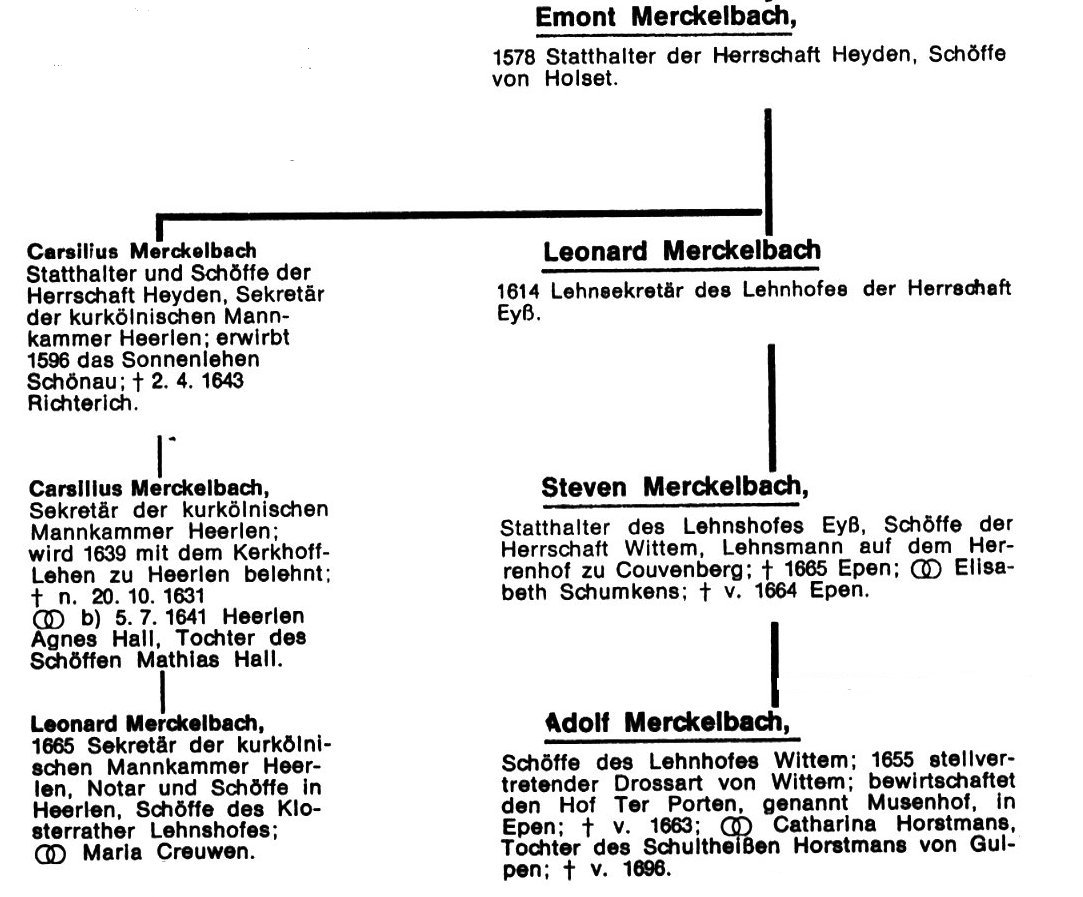
Lower left of Chart VIII-e. 5The Patriciaat further tells us that Leonard had two sons: Steven, married to Elisabeth Schumkens, and C[arcillis]. It names a nephew of Steven: Leonardus, notary in Heerlen. Those pieces of information correspond to what we had alright, but not to what we find in Dechamps. On this score the Dechamps manuscript and the Patriciaat do not merely disagree; they clash head-on. 6
The above chart as well as Dechamps' Chart VIII-f show Emont to be Leonard's father. However, the text accompanying VIII-f does not really state this to be so. What it does tell us is that Emont is vermütlich—presumably—Leonard's father, a presumption the charts had morphed into fact, a "fact" carried over into Kreutzwald's work, then into our Trunk–and goodness knows has infected many another published genealogy. 7
An article by professional genealogist Fons Patelski, Genealogie van de familie Merckelbach uit het Land van Herle in de 17e en 18e eeuw, provides more detailed information about the immediate descendants of Carcyllys Merckelbach and Cathryne NN: 8
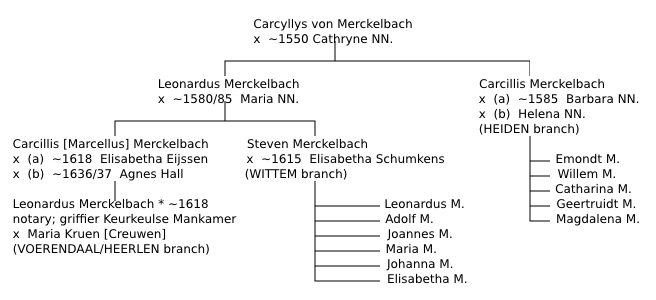
The immediate descendants of Carcyllys Merckelbach and Cathryne NN. 9This second chart partially accords with what we find on page 9 of the Dechamps manuscript: "A son of Carsilius, also named Carcillius, succeeds him as secretary of the kurkölnische Mannkammer, and in the year 1673 already is his grandson Leonard notary and secretary of the Mannkamer in Heerlen." We do have a father and son both named Carsilius, or a name close to it. However, Patelski does not tell us that Carcyllys was a secretary of the Kurkölnische Mannkammer, only that he rented a good from the Mannkammer. All of which still leaves us with that major dilemma: Who do we choose as Steven's grandfather, Emont or Carcyllys? 10
Sticking with the reputedly well-researched Patriciaat and article by Patelski, Carcyllys he darn well is; but where does he fit into Chart VIII-e? Might he be a son of Emont and thereby belong to a generation that had been lost sight of? Or might he be a brother of Emont? Or does the truth lie somewhere else altogether? Pondering this question, I made a tabulation of dates relevant to the offspring of Emont's father: Johann Von Merckelbach who in 1488 was a Rentmeister of Emont Von Palant as shown in Chart VIII-e. The purpose of this exercise was to see whether we can get decent horizontal line-ups of birthdays in order to bring distinct generations into clear view. Although available birthdates are few and far between, by adding some additional dates from our Trunk's database (in our table identified by ampersands) we hoped to make further half-decent guesstimates of birthdates from the given dates of marriage and high points in careers. For better or worse, here goes: 11
name:
born:
married:
career:
died: |
|
Heynrich
&1480
-
1521
- |
|
|
Reinhard
&1500
-
1536-1549
>1562 |
|
|
|
norm (of sorts)
1490;
brothers'
birthdates
20 yrs apart! |
name:
born:
married:
career:
died: |
Reinhard
=>1500/10
1535
1541-&1584
- |
Agnes
-
-
1570 witwe,1596
- |
Emont
-
-
&1572,1578
- |
|
Thomas
&1536
1565
&1558-1561
1587 |
Heinrich
&1530
-
&1568
‹1604 |
Peter
&1545
-
1571-1602
1604 |
Gottfried
&1542
1566
1563-1565
1571 |
1538
|
name:
born:
married:
career:
died: |
Dietrich
==>norm
-
1611
1620 |
Carsilius
-
-
&1578-1643
1643 |
Leonard
-
-
1614
- |
Reiner
&>1565
-
1608
- |
Heinr.Gosw.
›1565
&‹1598
1585 imm.
‹1614 |
Peter
&>1565
1607,1615
&1596
›&1616 |
Thomas
&1568
&1608
1596
&‹1621 |
Goswin
&1569
1610
&1593-1629
1641 |
1568
|
name:
born:
married:
career:
died: |
Dietrich
-
-
1620
1627 |
Carsilius
==>norm
2nd: 1641
1639
&1653 |
Steven
&‹1590
-
-
1665 |
Florenz
1589
1622,1626
&1636-1657
1667 |
Peter
1599
&1625
&1635-1677
1678 |
|
Hans Georg
&1609
1632
1628-1648
1680 |
Christian
1621
-
-
1659 |
1602
|
name:
born:
married:
career:
died: |
Daniel
1619
-
1648
- |
Leonard
-
-
1665,&1643-1685
- |
Adolf
&1620
&1646
&1645,1655
‹1663 |
Jan
&1615
-
&1644,&1645
1672 |
Joanna
-
-
-
‹1676 |
Elisabeth
-
-
-
‹1680 |
Leonard
&1625
-
1669,&1657,&1663
›1680 |
|
1620
|
name:
born:
married:
career:
died: |
Heinrich
-
1690,1695
-
- |
Caspar
1648
-
1681,1685
1704 |
Jan
‹1643,&1650
-
-
&1721 |
Anna
-
-
1680
&1729 |
Steven
&‹1648
-
1657-1674
&1703 |
Margriet
1650
-
1680
- |
Simon
-
-
1698
- |
|
1649
|
12And wow! What pops up? 13
Look at the date Heynrich's son Reinhard got married: 1535. That is some thirty years before the last column's norm (some sort of average) for what is supposed to be his generation. Clearly, Heynrich and his immediate offspring belonged to an earlier generation. From what little information we have about Emont's career period (governor of the Herrschaft Heyden and so forth), it appears that his CV lines up with that of Thomas, Heinrich, Peter, and Gottfried. Page 9 of the Dechamps' manuscript strongly suggests that Emont and Reinhard are indeed siblings. What all this then boils down to is that we have plenty of wiggle room for the patrician Carcyllys to fit in. Carcyllys may well be a son of Emont and the father of Leonard. This postulate demands, however, that in the left column must exist a generation between Reinhard and the elder Dietrich. Ahunting we shall go! 14
Time to turn our attention to Reinhard Merckelbach (t.1.3.1.3a.). And how fascinating! The database entry for Reinhard (ID t.1.3.1.3a. in the Thimistre/Frankenthal branch), presents us with a number of salient facts: 15
• Reinhard must have died after 1584
• Reynert [= Reinhard] has a son named Reynert, and daughters named Willemkenne, married to Winand Hannot, and Marguerite, married to Servais Jacob (entry dated 24.05.1576)
• A Reynert died before 1578, obviously the younger Reynert because the older one died after 1584. This younger Reynert was married to a Jehenne and had a son Thiry (= Dietrich) who was held prisoner by the army of Lord Dom Johann of Austria ("Sr Dom Johann daustriche") (entry dated 06.05.1578)
• "Dederich merkelabach" a resident of Aix (entry dated 03.08.1595)
• "Dederich merkelbach" a resident of Aix (entry dated 19.11.1611). 16
We found our missing generation! 17
Having established that after a son and a grandson of Heynrich von Merckelbach (t.1.3.1.) we ought to insert a generation, to wit the younger Reynert in Strasbourg and the Patriciaat's Carcyllys, we should also suspect that this Heynrich belongs to a generation older than that of the Reinhard who is married to Maria von Wirtzen (or Wierth), and especially so because their birthdates are said to be 20 years apart--see above table. A 20-year gap in birthdates among siblings is not exactly unheard of, but it is cause for suspicion. In our case we might take note of a comment on page 11 of Dechamps' manuscript, I'll translate: "In the year 1561, 'Lord Thomas' is made priest of Bedbur by Countess Elisabeth, who, after the death of her husband, exercises regency over her four underage children. He keeps his old father Reinhard and his brothers Peter, Heinrich and Eymond with him in his manse." Emphasize old. What, in those days, was considered old? 18
Let's now turn our attention for a moment to the first two scenarios of our Trunk diagrammed in the previous chapter. The questions that go through my mind is: What if the first scenario is correct for the Reinhard married to Maria von Wirtzen and the second scenario is correct for Heinrich, the father of Emont? No, I don't wish to add to the existing confusion and make this an "official" proposal. But let's just compare and contrast this with an entry on Wikipedia: http://de.wikipedia.org/wiki/Merckelbach, which presents us with a radically different set of family relationships: 19
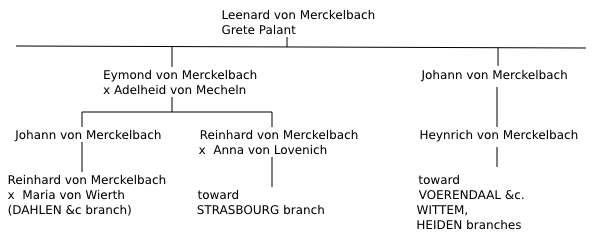
My "unofficial" hypothesis. 20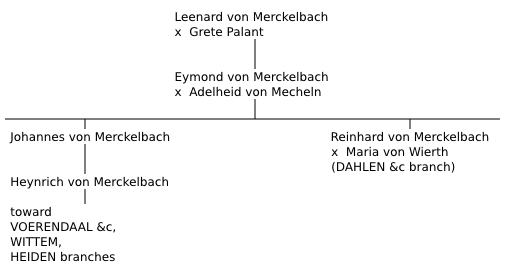
Family relationships present as fact on the internet. 21Whereas I made a hypothesis that might explain that Reinhard is younger than Heynrich, we find on the internet a document according to which Rheinhard is a generation older than Heynrich. All in all a good reason for just setting this issue aside. Right now a bigger issue needs to be resolved first, that of the tremendous discrepancy between those first two "Dechamps scenarios" (Chapter 2, ¶¶ 29 and 30) on the one hand and the Kreutzwald variation (¶ 31) on the other. From where I am sitting, I just don't know where to begin. 22
Bibliography
Principal literature of which original copies consulted:
Max Dechamps, Der Ursprung des Geschlechtes Merckelbach (Manuscript, 1967) Tableau VIIIe
Peter Kreutzwald, Ahnenforschung Kreutzwald: Stammbaum des Leonard (von) Merckelbach (Backup Nov. 19, 2011)
J. Kroes, ed., Nederlands Patriciaat (Centraal Bureau voor Genealogie, 2009) 201,202
A.S.M. Patelski, "Genealogie van de familie Merckelbach uit het land van Herle in de 17e en 18e eeuw" in John Schobre, ed., Jubileumboek het Land van Herle: Zestig Jaren Vorsen in de Geschiedenis van Parkstad Limburg (Stichting Historische Kring 'Het Land van Herle'. Heerlen, 2006) 182–284
Backups of external webpages 23
|
|
|
|
Future times: Co-operative editing and publishing 24
 1963 1963. The first computer mouse was part of an experiment to find better ways to point-and-click on a display screen. Made in a shop at SRI, the casing was carved out of wood. It had only one button, which was all there was room for. Subsequent models featured two and three buttons. Its inventor, Douglas "Doug" Engelbart, would have gone for even more buttons, but there was no more room than for three of the needed micro-switches available in those days. 24A1968. On December 9, a conference took place in San Francisco that brought much change to this world. The speaker of note was Douglas Engelbart who demonstrated, for the first time in public, the computer mouse as a tool for people to put their heads together by jointly scribbling on a computer screen. In fact, he showed two pointers dancing around on the screen, one controlled by a mouse in the conference hall, the other by a mouse handled by a co-worker at his Augmentation Research Laboratory, about 50 km away. The work was financed by a grant from the U.S. Air Force on the strength of a proposal titled Augmenting Human Intellect: A Conceptual Framework. 24B
 Engelbart's R & D work involved designing a suitable editor for highly efficient co-operative work. He looked for single-character inputs to manipulate texts (as distinct from typing), such as d for delete. He came up with this keyset for pressing command keys with the left hand while a three-button mouse was worked with the right hand. Its five keys permit 31 combination of pressed keys. That covers more than the alphabet. Uppercase characters are obtained by simultaneously pressing the middle mouse button. The left mouse button is pressed for digits and punctuation marks. Tests done in the early '60s showed that temporary secretarial help (known as the "Kelly Girls") mastered the keyset in less than two hours no-matter what method of training was used. The tests showed that the regular keyboard is more efficient for straightforward typing, but that for editing and maneuvering text, the mouse-keyset combination is the more efficient. 24CTo make such co-operation efficient, one must be able to instantaneously move through text. One way of doing so is with hyperlinks, but hyperlinks as we got to know them are not good enough for people to just about simultaneously move through text and insert their individual contributions to co-operative, "on paper" thinking. Such work calls for the efficient use of the keyset to permit a large number of editing actions to be performed by the single press of a key or button. Engelbart named his editor Augment. Besides its use for co-operative editing, Augment can equally well improve the efficiency of a single author. Too bad that there is no editor or word processor on today's market that comes even close to the capability of Augment. Two major obstacles prevented Engelbart's insights coming to fruition: (1) Augment comes with a learning curve rebuffed as tedious, and (2) he was unable to put his visionary use of Augment as a co-operative tool across clearly enough for business to go for it. That is where things stand right now, decades later! While Engelbart was pursuing augmenting humans to enhance intellectual productivity, society took the simpler route: plain automation. Only a few years ago I have seen Doug Engelbart in his office happily chording and typing away on his Augment-enabled computer, but, sadly, without a partner to co-operate with. Reference: Doug Engelbart Institute.* 24D
What has all this to do with our Merckelbach family tree? Quite a bit actually. Let me explain. 24E
Present. When I first wrote this chapter, I wrote what I was doing while doing it. I did not collect a lot of information and then sat down to organize it before writing it down away from other people's eyes–that time-honored way of writing. If I do not continually put the data and story on the Internet while producing them, potential users of the information must wait till I am good and well ready. Time-lag is time lost. But now, no matter how half-baked my ideas, they are available to those who can and may wish to critique them and/or co-operate in developing them. Of course, there is a problem with this way of doing: whatever one reads is not the final word by a long shot and readers could easily get confused. That problem ought be overcome by applying the method within a closed network of peers. And that, actually, is what Doug Engelbart had in mind. Tim Berners-Lee's public world-wide web came much later, around 1990. Having avoided experience with Augment leaves us stuck with todays's editors. Fine editors they are, no question about that. They speed things up by replacing manual work by automation. But they do not accelerate ideas coming to fruition by augmenting human intellect. In fact, confusion brought about by waddling through faulty information may have the opposite effect, it slows down critical thinking. If our politicians and economists could only do their texting the Augment way, how happier we all could be. 24F
Putting our subject matter aside, this is fundamentally a demonstration of publishing thoughts that need continual upgrading of content and, henceforth, continually revising the presentation of that content. While writing this chapter I felt in continual need for more or better background material. I'd like to have seen the reasoning and conclusions of others. I like any existing background material in my hands the very moment I am looking for it, something old-fashioned ways of publishing and communication do not permit. I am also in need of well-meant comments to improve my sluggishly developing and erroneous insights. This as well as the other chapters in our Merckelbach history are chapters in various stages of progress--from entirely unwritten to what seems finished. It should be obvious that this Chapter 3 is far from finished and even may contain misleading notions. Frequently I have also found myself reshuffling whole chapters, an exceedingly inefficient process which with Augment could have been done lickety-split. This kind of thing is, I feel sure, not just my experience. Many a book published today is already way out of date; even magazine articles tend to be behind the time. Worse, critique of what has been put in print comes too late to be of any immediate use. Fortunately, Internet publishing has already shown itself to beat publishing on paper hands down in terms of space, costs, speed. As for quality, Augment could have dealt with that. ¶24G
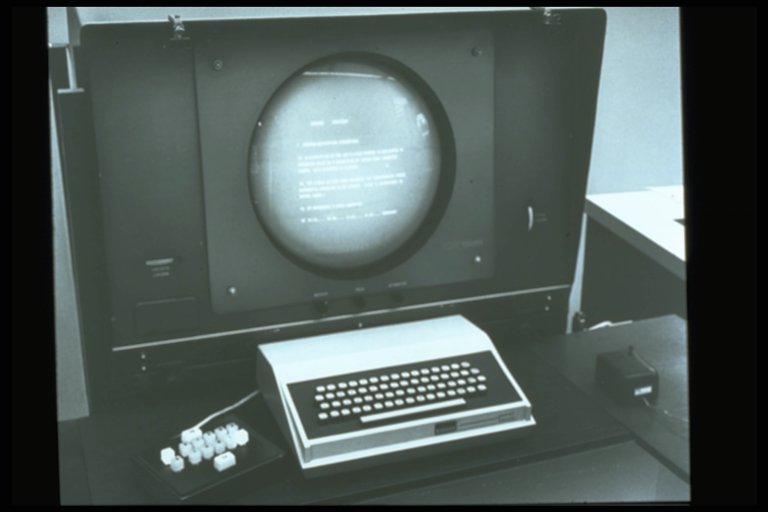
Model of a workstation which was custom-built around 1964-1966 at a cost. To the keyboard's right a mouse, to its left buttons for the rapid input of command codes for manipulating blocks of text. Those buttons have since been replaced by a device that is more efficient still than the common keyboard; it is the chording keyset shown in ¶ 24C, above. 24HFuture.There is so much to this website that, clearly, it will either die or be the subject of continual editing by people interested in its subject matter: a genealogy with roots way further down in the past. I like to think that in that case cooperative editing will become a useful discipline in this work as well as it will be used more generally. 24I
|
|
Footnotes
In August 2010, from Prof. Dr. H.L.G.J. Merckelbach who sent me also a copy of Max Dechamps' manuscript, Der Ursprung des Geschlechtes Merckelbach as well other useful background material. * fn1
This writer was for a number of years volunteer webmaster for what was then called the Bootstrap Institute, now Doug Engelbart Institute. * fn2
|






 Engelbart's R & D work involved designing a suitable editor for highly efficient co-operative work. He looked for single-character inputs to manipulate texts (as distinct from typing), such as d for delete. He came up with this keyset for pressing command keys with the left hand while a three-button mouse was worked with the right hand. Its five keys permit 31 combination of pressed keys. That covers more than the alphabet. Uppercase characters are obtained by simultaneously pressing the middle mouse button. The left mouse button is pressed for digits and punctuation marks. Tests done in the early '60s showed that temporary secretarial help (known as the "Kelly Girls") mastered the keyset in less than two hours no-matter what method of training was used. The tests showed that the regular keyboard is more efficient for straightforward typing, but that for editing and maneuvering text, the mouse-keyset combination is the more efficient.
Engelbart's R & D work involved designing a suitable editor for highly efficient co-operative work. He looked for single-character inputs to manipulate texts (as distinct from typing), such as d for delete. He came up with this keyset for pressing command keys with the left hand while a three-button mouse was worked with the right hand. Its five keys permit 31 combination of pressed keys. That covers more than the alphabet. Uppercase characters are obtained by simultaneously pressing the middle mouse button. The left mouse button is pressed for digits and punctuation marks. Tests done in the early '60s showed that temporary secretarial help (known as the "Kelly Girls") mastered the keyset in less than two hours no-matter what method of training was used. The tests showed that the regular keyboard is more efficient for straightforward typing, but that for editing and maneuvering text, the mouse-keyset combination is the more efficient. 